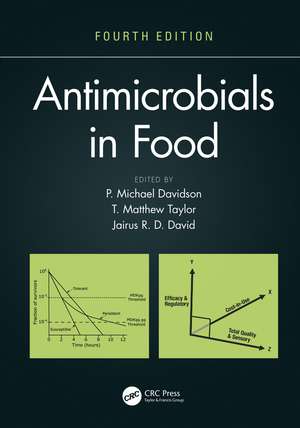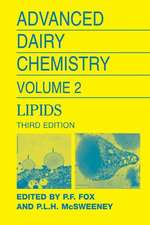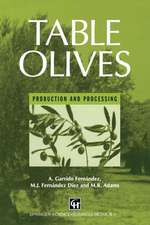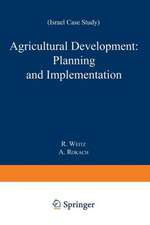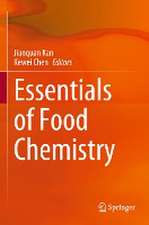Antimicrobials in Food: Food Science and Technology
Autor P. Michael Davidson, T. Matthew Taylor, Jairus R.D. Daviden Limba Engleză Hardback – oct 2020
Fifteen years have passed since the 3rd Edition of Antimicrobials in Foods was published. It was arguably considered the "must-have" reference for those needing information on chemical antimicrobials used in foods. In the years since the last edition, the food industry has undergone radical transformations because of changes on several fronts. Reported consumer demands for the use of "natural" and "clean-label" antimicrobials has increased significantly. The discovery of new foodborne pathogen niches and potentially hazardous foods, along with a critical need to reduce food spoilage waste, has increased the need for suitable antimicrobial compounds or systems. Novel natural antimicrobials continue to be discovered and new research has been carried out on traditional compounds. These and other related issues led the editors to develop the 4th Edition of Antimicrobials in Foods.
In the 4th Edition, the editors have compiled contemporary topics with information synthesized from internationally recognized authorities in their fields. In addition to updated information, new chapters have been added in this latest release with content on the use of bacteriophages, lauric arginate ester, and various systems for antimicrobial encapsulation and delivery. Comprehensive revisions of landmark chapters in previous editions including naturally occurring antimicrobials from both animal and plant sources, methods for determining antimicrobial activity, new approaches to multifactorial food preservation or "hurdle technology," and mechanisms of action, resistance, and stress adaptation are included. Complementing these topics is new information on quantifying the capability of "clean" antimicrobials for food preservation when compared to traditional food preservatives and industry considerations when antimicrobials are evaluated for use in food manufacture.
Key Features:
- Covers all food antimicrobials, natural and synthetic, with the latest research on each type
- Contains 5,000+ references on every conceivable food antimicrobial
- Guides in the selection of appropriate additives for specific food products
- Innovations in antimicrobial delivery technologies and the use of multifactorial food preservation with antimicrobials are included
Din seria Food Science and Technology
- 25%
 Preț: 618.61 lei
Preț: 618.61 lei - 22%
 Preț: 1024.09 lei
Preț: 1024.09 lei -
 Preț: 357.25 lei
Preț: 357.25 lei - 22%
 Preț: 842.01 lei
Preț: 842.01 lei - 23%
 Preț: 553.64 lei
Preț: 553.64 lei - 15%
 Preț: 489.26 lei
Preț: 489.26 lei - 18%
 Preț: 1359.95 lei
Preț: 1359.95 lei - 18%
 Preț: 1674.26 lei
Preț: 1674.26 lei - 8%
 Preț: 323.02 lei
Preț: 323.02 lei - 30%
 Preț: 614.87 lei
Preț: 614.87 lei - 18%
 Preț: 2090.27 lei
Preț: 2090.27 lei - 15%
 Preț: 489.26 lei
Preț: 489.26 lei - 29%
 Preț: 1408.52 lei
Preț: 1408.52 lei - 23%
 Preț: 566.29 lei
Preț: 566.29 lei - 13%
 Preț: 385.35 lei
Preț: 385.35 lei - 15%
 Preț: 498.42 lei
Preț: 498.42 lei - 30%
 Preț: 2111.13 lei
Preț: 2111.13 lei - 18%
 Preț: 1827.77 lei
Preț: 1827.77 lei - 18%
 Preț: 2081.08 lei
Preț: 2081.08 lei - 18%
 Preț: 2212.49 lei
Preț: 2212.49 lei - 18%
 Preț: 2220.38 lei
Preț: 2220.38 lei - 18%
 Preț: 2221.95 lei
Preț: 2221.95 lei - 23%
 Preț: 606.02 lei
Preț: 606.02 lei - 18%
 Preț: 2078.06 lei
Preț: 2078.06 lei - 23%
 Preț: 415.15 lei
Preț: 415.15 lei - 18%
 Preț: 2102.06 lei
Preț: 2102.06 lei - 23%
 Preț: 376.17 lei
Preț: 376.17 lei - 18%
 Preț: 1604.01 lei
Preț: 1604.01 lei - 18%
 Preț: 2770.03 lei
Preț: 2770.03 lei - 15%
 Preț: 537.13 lei
Preț: 537.13 lei - 18%
 Preț: 2211.41 lei
Preț: 2211.41 lei - 18%
 Preț: 2233.32 lei
Preț: 2233.32 lei - 27%
 Preț: 1420.06 lei
Preț: 1420.06 lei - 18%
 Preț: 1395.65 lei
Preț: 1395.65 lei - 31%
 Preț: 1702.47 lei
Preț: 1702.47 lei - 18%
 Preț: 1926.00 lei
Preț: 1926.00 lei - 29%
 Preț: 1409.34 lei
Preț: 1409.34 lei - 18%
 Preț: 1800.14 lei
Preț: 1800.14 lei - 18%
 Preț: 1336.46 lei
Preț: 1336.46 lei - 18%
 Preț: 1959.17 lei
Preț: 1959.17 lei - 31%
 Preț: 1690.32 lei
Preț: 1690.32 lei - 22%
 Preț: 836.17 lei
Preț: 836.17 lei - 18%
 Preț: 1941.91 lei
Preț: 1941.91 lei - 18%
 Preț: 1222.82 lei
Preț: 1222.82 lei - 18%
 Preț: 701.01 lei
Preț: 701.01 lei
Preț: 1313.74 lei
Preț vechi: 1602.12 lei
-18% Nou
251.42€ • 261.51$ • 207.56£
Carte tipărită la comandă
Livrare economică 15-29 aprilie
Specificații
ISBN-10: 0367178788
Pagini: 826
Ilustrații: 101 Tables, black and white; 69 Illustrations, black and white
Dimensiuni: 178 x 254 x 44 mm
Greutate: 1.64 kg
Ediția:Nouă
Editura: CRC Press
Colecția CRC Press
Seria Food Science and Technology
Public țintă
Professional ReferenceCuprins
Descriere
Fifteen years have passed since the 3rd Edition of Antimicrobials in Foods was published. It was arguably considered the "must-have" reference for those needing information on chemical antimicrobials used in foods. In the years since the last edition, the food industry has undergone radical transformations because of changes on several fronts. Reported consumer demands for the use of "natural" and "clean-label" antimicrobials has increased significantly. The discovery of new foodborne pathogen niches and potentially hazardous foods, along with a critical need to reduce food spoilage waste, has increased the need for suitable antimicrobial compounds or systems. Novel natural antimicrobials continue to be discovered and new research has been carried out on traditional compounds. These and other related issues led the editors to develop the 4th Edition ofAntimicrobials in Foods.
In the 4th Edition, the editors have compiled contemporary topics with information synthesized from internationally recognized authorities in their fields. In addition to updated information, new chapters have been added in this latest release with content on the use of bacteriophages, lauric arginate ester, and various systems for antimicrobial encapsulation and delivery. Comprehensive revisions of landmark chapters in previous editions including naturally occurring antimicrobials from both animal and plant sources, methods for determining antimicrobial activity, new approaches to multifactorial food preservation or "hurdle technology," and mechanisms of action, resistance, and stress adaptation are included. Complementing these topics is new information on quantifying the capability of "clean" antimicrobials for food preservation when compared to traditional food preservatives and industry considerations when antimicrobials are evaluated for use in food manufacture.
Key Features:
- Covers all food antimicrobials, natural and synthetic, with the latest research on each type
- Contains 5,000+ references on every conceivable food antimicrobial
- Guides in the selection of appropriate additives for specific food products
- Innovations in antimicrobial delivery technologies and the use of multifactorial food preservation with antimicrobials are included
